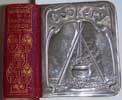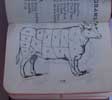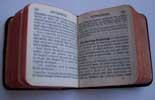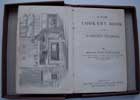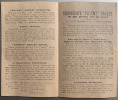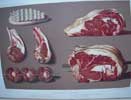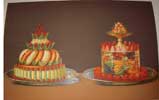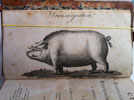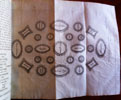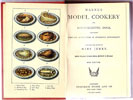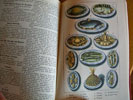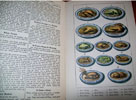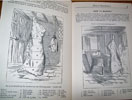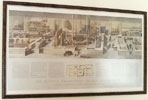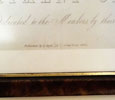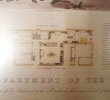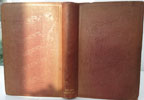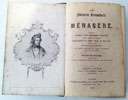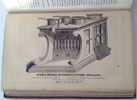Collingwood. F.
and Woolams. J.
- Purchased in India during the British Raj
THE UNIVERSAL COOK,
AND City and Country Housekeeper. CONTAINING ALL THE VARIOUS BRANCHES OF COOKERY: THE DIFFERENT METHODS OF DRESSING Butchers Meat, Poultry, Game, and Fish; AND OF PREPARING GRAVIES, CULLICES, SOUPS, AND BROTHS; TO DRESS ROOTS AND VEGETABLES, AND TO PREPARE Little elegant Dishes for Supper or light repasts: TO MAKE ALL SORTS OF PIES. PUDDINGS, PANCAKES, AND FRITTERS; CAKES, PUFFS, AND BISCUITS; CHEESECAKES, TARTS, AND CUSTARDS; CREAMS AND JAMS; BLANC MANGE, FLUMMERY, ELEGANT ORNAMENTS, JELLIES, AND SYLLABUBS. THE VARIOUS ARTICLES IN CANDYING, DRYING, PRESERVING, AND PICKLING. THE PREPARATION OF HAMS, TONGUES, BACON, &C. DIRECTIONS FOR TRUSSING POULTRY, CARVING, AND MARKETING. THE MAKING AND MANAGEMENT OF Made Wines, Cordial Waters, and Malt Liquors. TOGETHER WITH Directions for Baking Breads, the Management of Poultry and the Dairy, and the Kitchens and Fruit Garden; with a Catalogue of the Various articles in Season in the different Months of the Year. BESIDES A VARIETY OF USEFUL AND INTERESTING TABLES. THE WHOLE EMBELLISHED WITH THE HEADS OF THE AUTHORS, BILLS FOR EVERY MONTH OF THE YEAR, AND PROPER SUBJECTS FOR THE IMPROVEMENTS OF THE ART OF CARVING, ELEGANTLY ENGRAVED ON FOURTEEN COPPER-PLATES. By FRANCIS COLLINGWOOD, and JOHN WOOLLAMS. Principal Cooks at the Crown and Anchor Tavern in the Strand ---- Late from the London Tavern. THIRD EDITION. LONDON: PRINTED BY C. WHITTINGHAM, Dean Street, Fetter Lane, FOR J. STACHARD, No. 12, AVE-MARIE-LANE; H.D. SYMONDS AND HURST, PATERNOSTER-ROW; RICHARDSONS, ROYAL EXCHANGE; MARSH AND DUNSFORD, FLEET-STREET; GARNER, WESLEY, AND STARND, STRAND; LAKING, CURZON-STREET; DANGERFIELD, BERKLEY-SQUARE; MILLAR, AND JORDAN HOOKHAM BOND-STREET; KIRBY, OXFORD-STREET; LINDSELL, WIMPOLE-STREET; LLOTD, CAVENDISH-STREET;--1801.
8vo. 2feps. Half title. [2] Frontispiece of both authors. Title page. [1] 4p. Preface. 20p Contents. 12 engraved plates of bills of fare for every month. (1)2-432. 433-444 A Catalogue. 445-451 Marketing Tables. [1] Advertising. 2feps. Half dark brown modern calf with marbled boards and calf corners. The pages very lightly age browned with some manuscript notes. There an interesting manuscript note on the first page of recipes; "Bought this book from Col. David Smothen [?] and gave him 8 rupees for Mrs Smothen".(Probably a frugal mem-sahib selling the book before leaving for England). The whole text block has been trimmed slightly without loss of text. The third appears to be a very scarce edition, as none are cited in the bibliographies. A nice copy.
-
F. Collingwood and J. Woollams had the unique distinction of having their first edition of ‘The Universal Cook’ of 1792, being translated into French and sold in France. Published in Paris in 1810 it was re-named ‘ Le Cuisinier Anglais Universal ou le Nec Plus Ultra de la Gourmandise’. This was the time of the war with Napoleon, but the reputation of London food and its Cooks stood high with foreigners. The first smart restaurant to open in Paris the same year as ‘The Universal Cook’ was published, was called La Grande Taverne de Londres, after the London Tavern, where John Farley its famous Chef was serving his tenure. Collingwood and Woollams had also had a spell at the London Tavern, so one assumes they were as well known as Farley. In spite of the fame and glory of Collingwood and Woollams’ book being translated into French, the French publisher had qualms. In his introduction, he wrote: “The English must eat well, look at their 'embonpoint!' If occasional recipes seem odd, they will at least, 'cher lecteur,' broaden your experience, acquainting you with ‘le catchup’ and ‘le browning’ which are unknown even to our best chefs.” In this age, with our British chefs feeling a need to bow in humble acknowledgement of the superior French culinary tradition and possible superior expertise (although this has definitely been changing in recent years) one is surprised by the above words of the French publisher. Collingwood and Woollams in turn, inform us grandly in their Preface: ‘We shall not attempt to ransack the annals of Antiquity, with a view to discover what was the food of our first parents in the garden of Eden, or in the manner they performed their culinary operation: It is sufficient for us to know a[t] present, that Cookery is become a Science, that every age has contributed its mite to the improvement of this art, which seems now to have reached a very high degree of perfection.’ Interesting! – I’m sure, Joel Robuchon, Gorden Ramsey, Paul Bocuse, Ferran Adria, Heston Blumenthal, Rick Stien, Alain Ducasse et al, are saying the same thing now, and that the great cooks of two or three generations hence, will express the same sentiments; How things change, but ultimately stay the same!.






|
|

Antiquarian category
ref number:
10972
|
